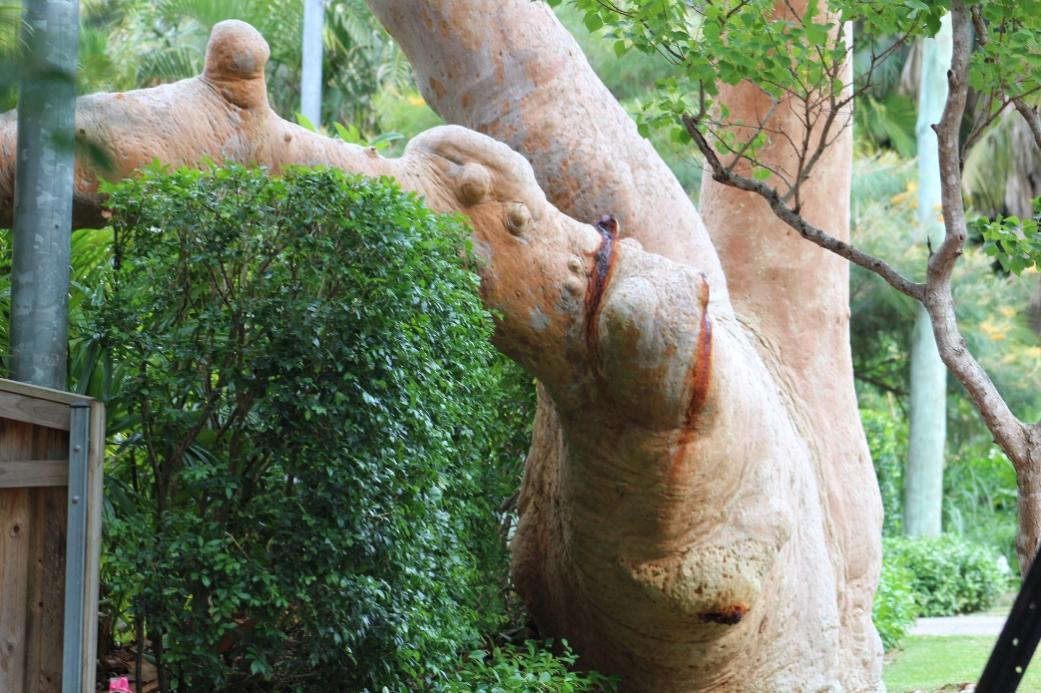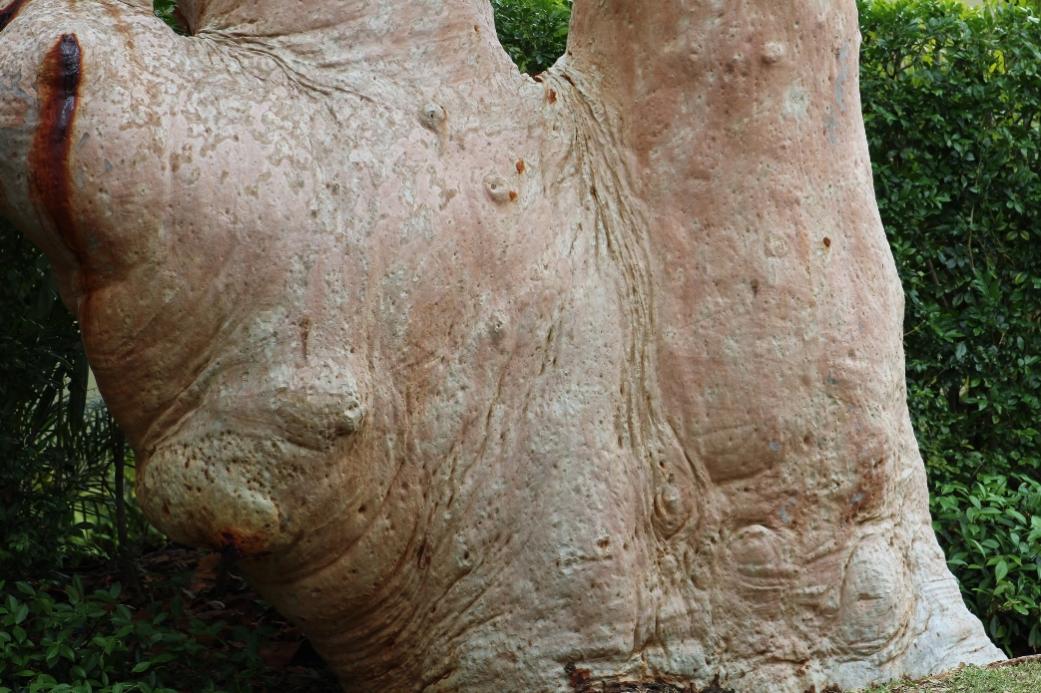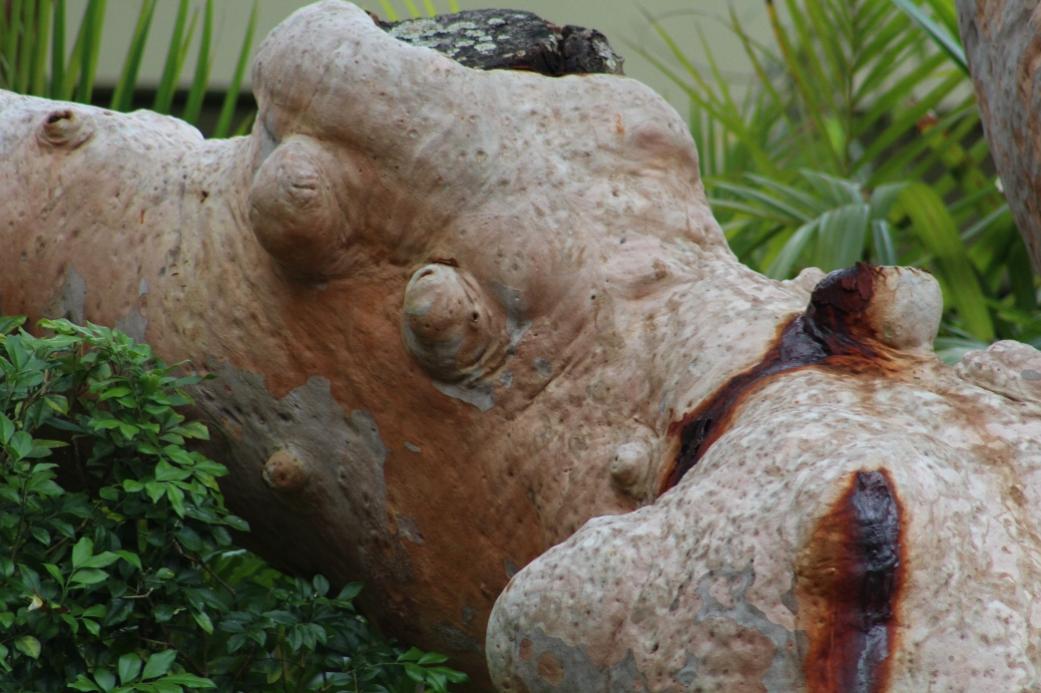January 21 - 27, 2018: Issue 344
Angophora Costata: Pittwater
Angophora Costata: Trees In Your Streets - Pittwater
Smooth-barked Apple
Angophora - from two Greek words, meaning 'vessel' or 'goblet', and 'to bear or carry', referring to the shape of the fruits; costata - ribbed; the capsules bear prominent ribs
The genus Angophora is closely allied to Corymbia and Eucalyptus (family Myrtaceae) but differs in that it usually has opposite leaves and possesses overlapping, pointed calyx lobes instead of the operculum or lid on the flower buds found in those genera.
Angophora costata, or Smooth-barked Apple, is a large, wide, spreading tree growing to a height of between 15 and 25 m. The trunk is often gnarled and crooked with a pink to pale grey, sometimes rusty-stained bark. The timber is rather brittle. In nature the butts of fallen limbs form callused bumps on the trunk and add to the gnarled appearance. The old bark is shed in spring in large flakes with the new salmon-pink bark turning to pale grey before the next shedding. The leaves are dark green, lance-shaped, 6-16 cm long and 2-3 cm wide. They are borne opposite each other on the stem.
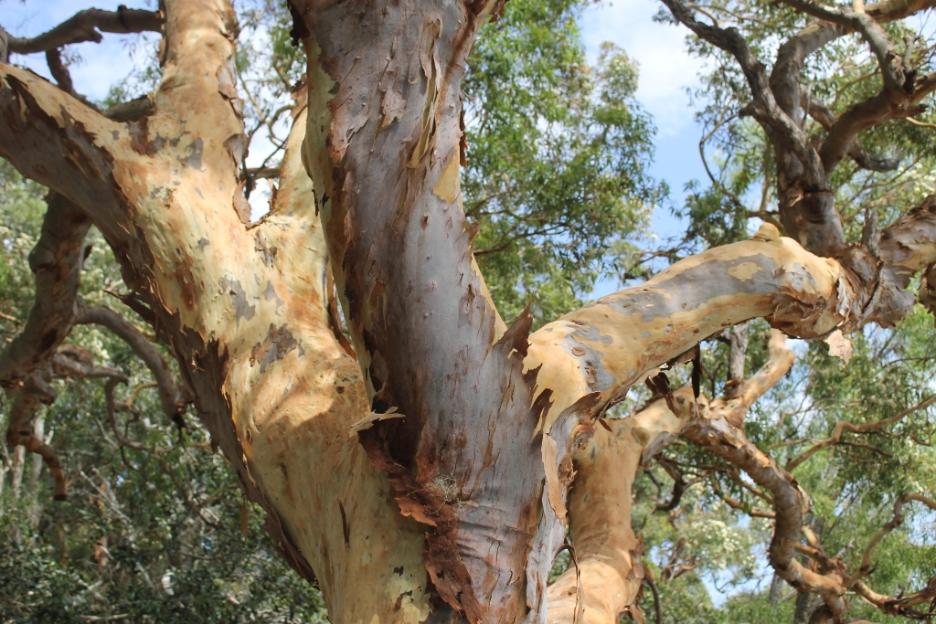
Angophora costata - shedding old bark
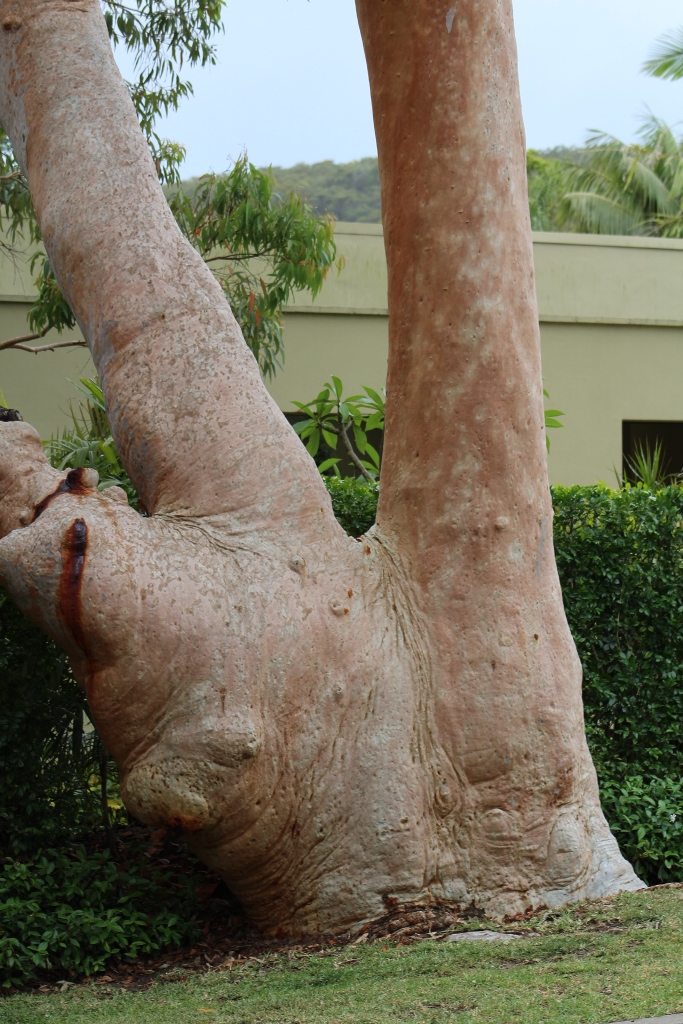
The flowers are white and very showy, being produced in large bunches on terminal corymbs or short panicles. The individual flowers are about 2 cm wide with five tooth-like sepals, five larger semi-circular petals, and a large number of long stamens. The seed capsules are goblet shaped, 2 cm long and as wide, often with fairly prominent ribs. The usual recorded flowering time is December or January, but at the Australian National Botanic Gardens in Canberra the species flowers for about one month between early January and early February. The tree has a handsome, rugged ornamental appearance and its young red tips are often used in floral arrangements.
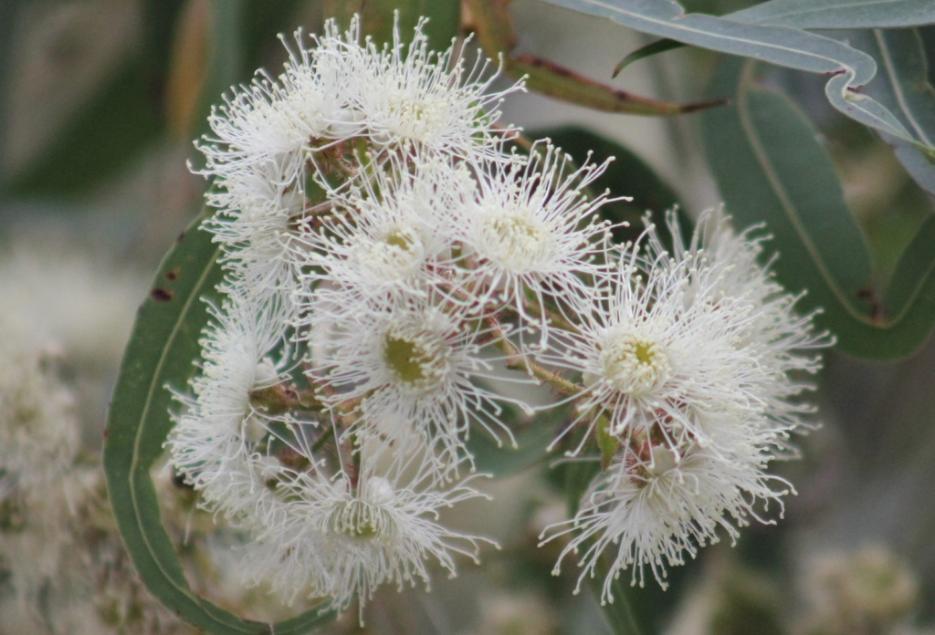
Angophora costata - currently flowering.
Angophora costata occurs naturally on the sandy soils and stony ridges of southern Queensland forests, extending inland as far as the Warrego district. In NSW it extends from Sydney northwards to the central coast and as far west as Bathurst, being particularly common on Hawkesbury sandstone where it forms almost pure stands. Rainfall in these areas varies between 635-1520 mm.
The species is grown from seed which normally germinates after seven days and no special treatment is required. The seed should be sown in a loose, well-drained mix just below the surface. When the seedlings reach a height of 1-2 cm they should be pricked out into a large container until they are large enough to be planted out.
Some trees suffer minor frost damage to new tips during winter, and caterpillars and the native leaf-cutting bee cause minor damage to the foliage. All eucalypts have an efficient method for shedding limbs, as described by Jacobs (1955). For this reason, larger species such as A. costata should not be planted so that they will overhang dwellings.
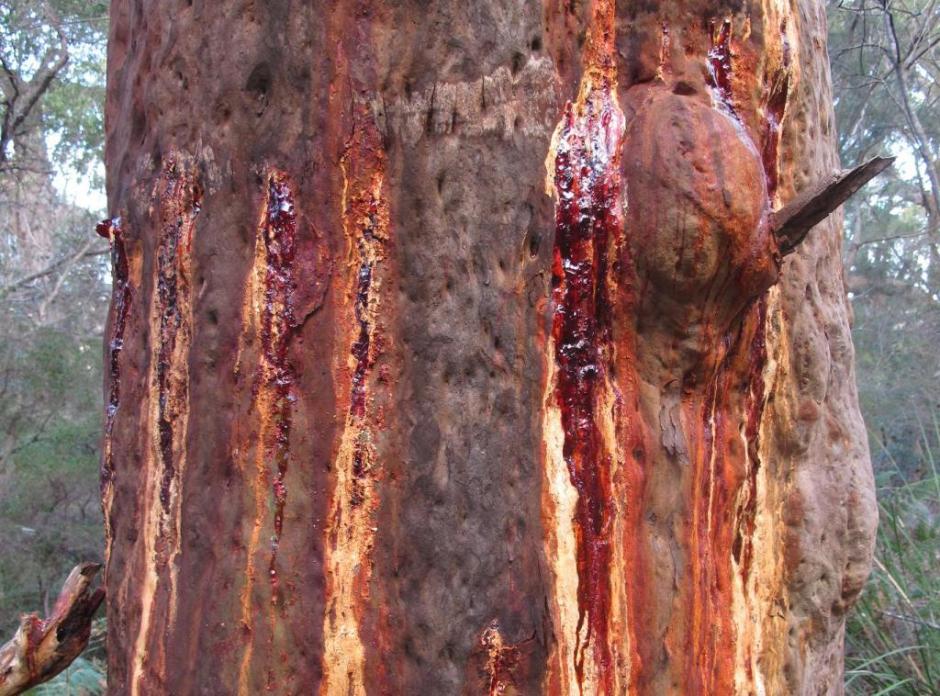
Above photo is of gum on an angophora costata. This indicates that it is being attacked by insects, but defending itself by exuding gum, called kino. This traps and smothers the insects, probably wood boring beetle grubs. Abundant kino is a sign of a healthy tree. Photo by Marita Macrae, 2015
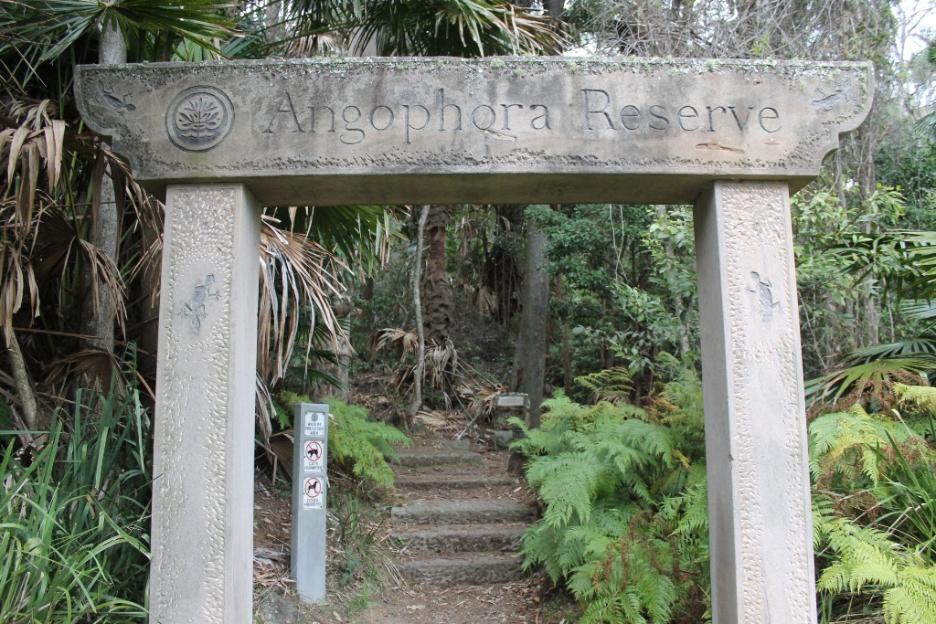
Original text by ANBG staff (1978); since updated online. Photos by Marita Macrae and A J Guesdon, 2011 to 2018
ANCIENT RED GUM.
Centre of New Reserve.
BUSH NEAR AVALON.
'Set aside by' the Wild Life Preservation Society of Australia, primarily for the preservation of a giant example of the Sydney red-gum (Angophora lanceolata), the Angophora Reserve, at Avalon, was officially opened on Saturday afternoon by Sir Philip Street.
The president of the society (Mr. W. G. Kett) said the reserve was a memorial to the line work in the cause of science done by their secretary, Mr. D. G. Stead.
Sir Philip Street said that the society, in preserving this great tree as a natural monument and setting apart the area with its interesting fauna and flora, was rendering a public service.
The magnificent angophora, on which many axemen must have cast covetous eyes, was, he had been told, about 1,000 years old.
Mr. Kett said that, in the reserve, which contained about six and a half acres, there were many varieties of Australian trees and shrubs, and it was also the rendezvous of some of the most beautiful Australian birds.
Other speakers were the president of Warringah Shire, Councillor Green, Messrs. R. T. Baker, and D. G. Stead.
The reserve is a fine example of Australian bush land, rising from a small valley to the top of a hill overlooking the coast and Broken Bay. About 150 persons attended Saturday's function.
After the function, the visitors were entertained at afternoon tea by the society at the Avalon Golf House.
ANCIENT RED GUM. (1938, March 21).The Sydney Morning Herald (NSW : 1842 - 1954), , p. 9. Retrieved from http://nla.gov.au/nla.news-article17450337
Beautiful, isn't it?
A magnificent redgum, probably 1000 years old, has been "dedicated" in the six-acre Angophora Reserve at Avalon. We wonder who will sit in the shade of this big tree after another 1000 years? What color will he be, and in what language will they whisper? One thing, will, endure. The tree is close to the Avalon Golf Links; and whether Redgum lives to be 2000 or 3000 years old; the world will still talk golf. A WINDOW ON THE WORLD (1938, March 22). The Sun (Sydney, NSW : 1910 - 1954), p. 4 (LATE FINAL EXTRA). Retrieved from http://nla.gov.au/nla.news-article229877986
THE "ANGOPHORA" RESERVE
Preserving Australia's Fauna
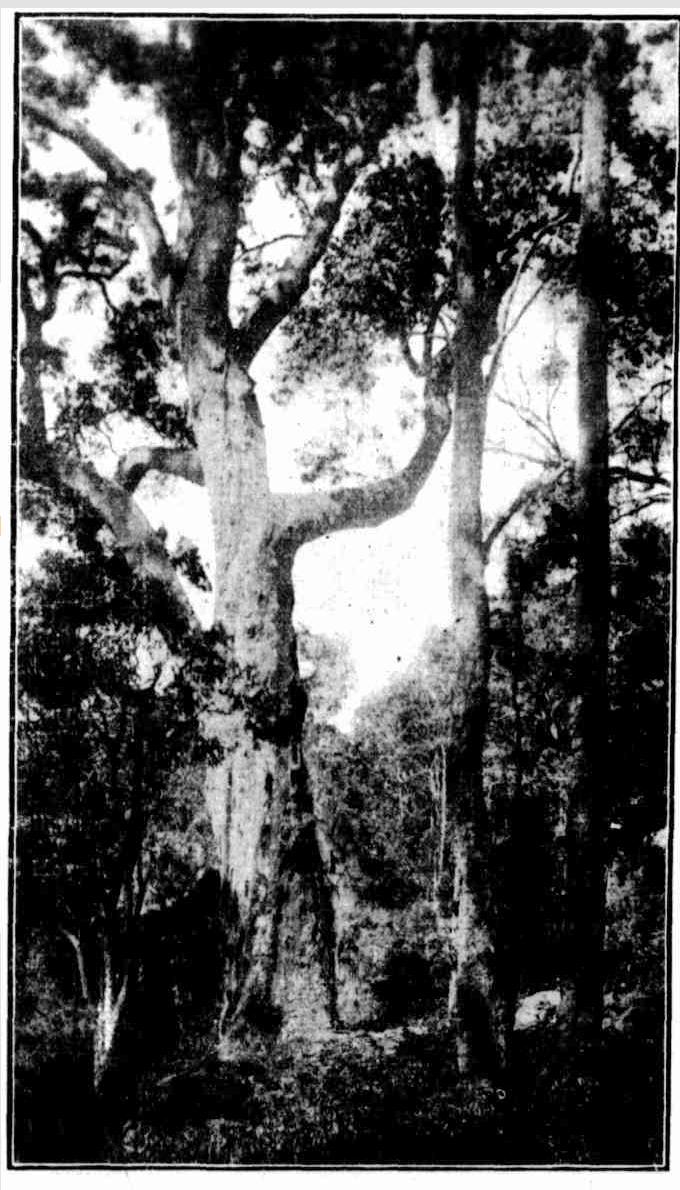
The Angophora Reserve, which is the Wild Life Preservation Society's new Bushland Sanctuary at Avalon, N.S.W., was officially opened and dedicated by the Hon. Sir Phillip Street, K.C.M.G., on Saturday last, March 19th. This reserve had been set aside primarily for the preservation of a giant 'example of the Sydney Red Gum (Angophora lanceolata) as a national monument. Owing to the junction of two great geological forms (Hawkesbury sandstone and Narrabeen shales) at this spot, the trees and shrubs present many features of interest to the botanist, field naturalist and bush lover.
THE “ANGOPHORA” RESERVE (1938, March 23). Construction and Real Estate Journal (Sydney, NSW : 1930 - 1938), p. 7. Retrieved fromhttp://nla.gov.au/nla.news-article222925110
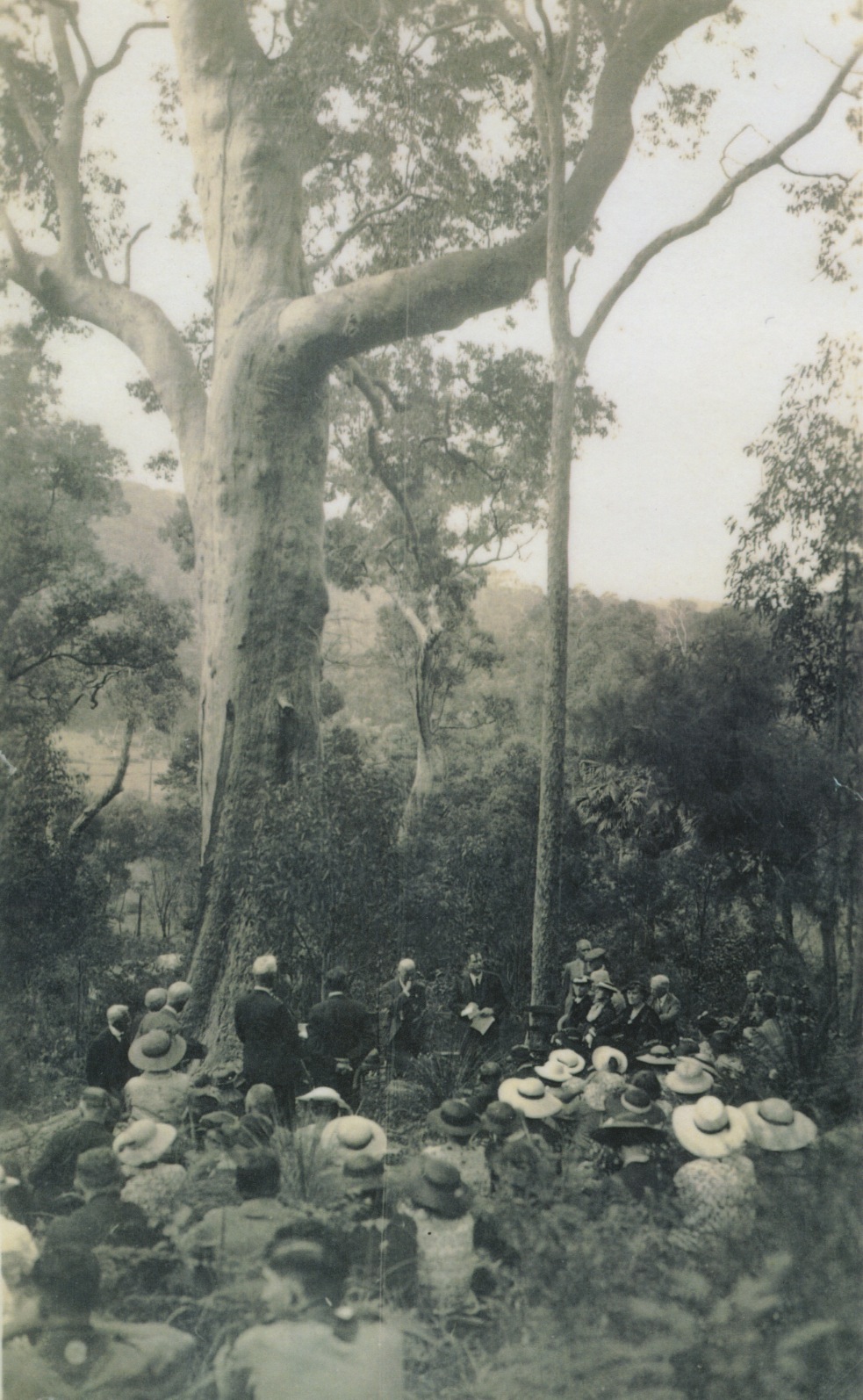
This photo shows the official opening of the Angophora Reserve on 19 March 1938 by Sir Phillip Street (KCMG). Much of the groundwork to enable the purchase of the land by the Wildlife Preservation Society in January 1937 was done by Thistle Harris. The reserve cost the Society 364 pounds 19 shillings and 7 pence (which converts to around 730 dollars!). The volunteer bush care group meet on the 3rd Sunday of each month usually at the Palmgrove Road entrance. – Geoff Searl, President of the Avalon Beach Historical Society - photo courtesy ABHS
The Birds Laughed!
A PARTY of our C.P. girls accompanied Cinderella to Avalon on March 19 to attend the official opening of the Angophora Reserve, a forest sanctuary purchased by the Wild Life Preservation Society and dedicated to the conservation of Sydney's largest redgum (Angophora Ianceolata), a giant possibly 1000 years old, but still in his prime. As the different speakers addressed the guests scattered over the grass, on the importance of preserving our beautiful bush and teaching the young generation to reverence such splendid national treasures as our forests contain, loud applause came from an unexpected quarter. A group of kookaburras had accepted the invitation for all forest-lovers to celebrate the day, and shouted their glee from the branches overhead. It was the mast eloquent of all the tributes paid that day to the value of tree-conservation. Who says that birds can't understand?
The Birds Laughed! (1938, March 30). Sydney Mail (NSW : 1912 - 1938), p. 63. Retrieved from http://nla.gov.au/nla.news-article166229598
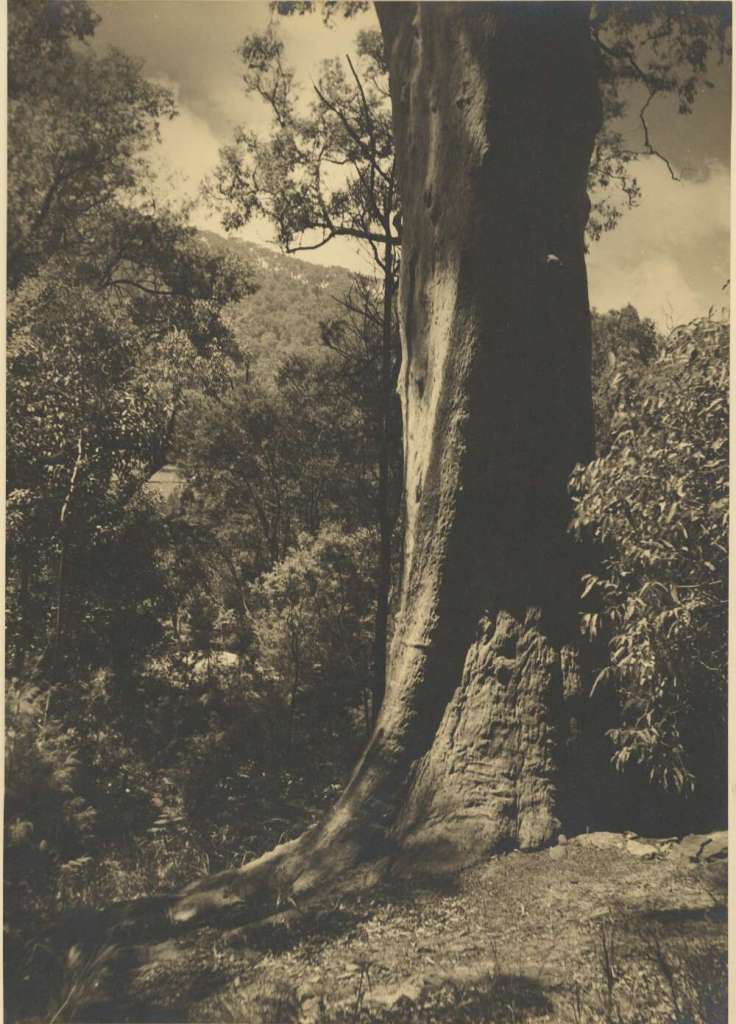
Searle, E. W. Red gum, angophora lanceolata, Avalon, New South Wales, circa. 1935 Retrieved from http://nla.gov.au/nla.obj-142184682
THE OPENING CEREMONY, ANGOPHORA PARK, AVALON, 19th MARCH, 1938

The ceremony took place beneath the giant Angophora (Red Gum) which is estimated to be 1,000 years old. In this native bushland, only one hour's run from the city, flora and fauna will find sanctuary for all time, thanks to the enterprise of Mr. David G. Stead, the Wild Life Preservation Society and Mr. A. J. Small who released the land at a tithe of its value.
THE OPENING CEREMONY, ANGOPHORA PARK, AVALON, 19th MARCH, 1938 (1938, April 6). Construction and Real Estate Journal (Sydney, NSW : 1930 - 1938), p. 8. Retrieved from http://nla.gov.au/nla.news-article222925313
AVALON
Another Contribution by A. J. Small
When the history of Avalon is written, one man's name in particular will be outstanding. It is that of Mr. A. J. Small. Not only has he given headlands and parklands to the people to preserve for them vantage points from which ocean views can be seen for all time, but he is still giving. His last act of graciousness was when he gave an area of seven acres of land at half value in order that the Wild Life Preservation Society could acquire its Angophora Park. Mr. Small also erected the fence and iron gates, made the approach, built the steps, and cleared the paths so that the giant Angophora (sometimes called Red Gum) which is said to be 1,000 years old and of immense girth, may be viewed in its natural surroundings. At the time of the opening (by Sir Phillip Street on March 19th) there was an improvised orchestra of birds — butcher birds, soldier birds, warblers, and jackasses, in fact a representative from practically all the feathered families — which came down to look curiously on the people who attended the opening and to contribute, to the scene. Afterwards, 100 invited guests accepted Mr. Small's hospitality to afternoon tea at the New Golf House at Avalon. The fine golf course there has not a club. All visitors can play there on an equal footing, and in this respect it occupies a unique position among the metropolitan golf courses. The new building, illustrated herewith, is of white sandstone with buttressed corners. The internal walls are of brick. In the lower storey are locker and retiring rooms for golfers with hot and cold showers for both sexes. The upper walls are shingled and the roof is covered with semi' glazed brown tiles. It is mainly occupied by a large combined lounge and dining room about 60 feet in length. The flooring is of tallowwood designed for dancing. For log fires in winter, an open fireplace, framed in 9in. x 2in. briquettes, has been provided, with a hearth of 9 feet wide. Manchurian Ash of exceptional figure lines the lounge artistically furnished in autumn tints. The architect for the golf building was E. Lindsay Thompson, and F. C. Fripp, the builder. AVALON (1938, April 6). Construction and Real Estate Journal (Sydney, NSW : 1930 - 1938), , p. 8. Retrieved from http://nla.gov.au/nla.news-article222925312
Angophora Reserve notes from Warringah Shire Council Records:
March 15th, 1938: 37. Wild Life Preservation Society, 6/3/38, inviting the Councillors to the Official Opening of the Angophora Reserve at Avalon at 3 p.m. on Saturday, 19th inst., the said Reserve having been set aside by the Society for the preservation of a giant example of the Sydney Red Gum and other flora. Resolved, - That the Society be informed it is regretted no one will be able to be present. 38.. L.R.Duncan & G.A.Lamb 5/3/38, stating that by the recent fencing of prte land they have been deprived of access long enjoyed by them to Surf Road, Whale Beach, requesting Council to resume a strip of land from Surf. Road along the ridge to give access to their house, stating they are prepared to give a strip alone the rear of their property for the purpose. Resolved, - That the Works Committee inspect and report.
Ordinary Meeting, 14/10/41. 32. E. O. Hanson, 6/10/41, re Angophora Reserve, Avalon, expressing pleasure at its transfer to the Council, and stating he is unable to carry out the duties of Honorary Ranger owing Reserve to ill-health, and suggesting that Dr. Eric Pockley would be an excellent man for the position. Resolved, - That inquiries be made whether Dr. Pockley is a permanent resident of Avalon, and if he is, he be invited to accept the position of Honorary Ranger of the Reserve: (Crs. O'Reilly, Bathe)
